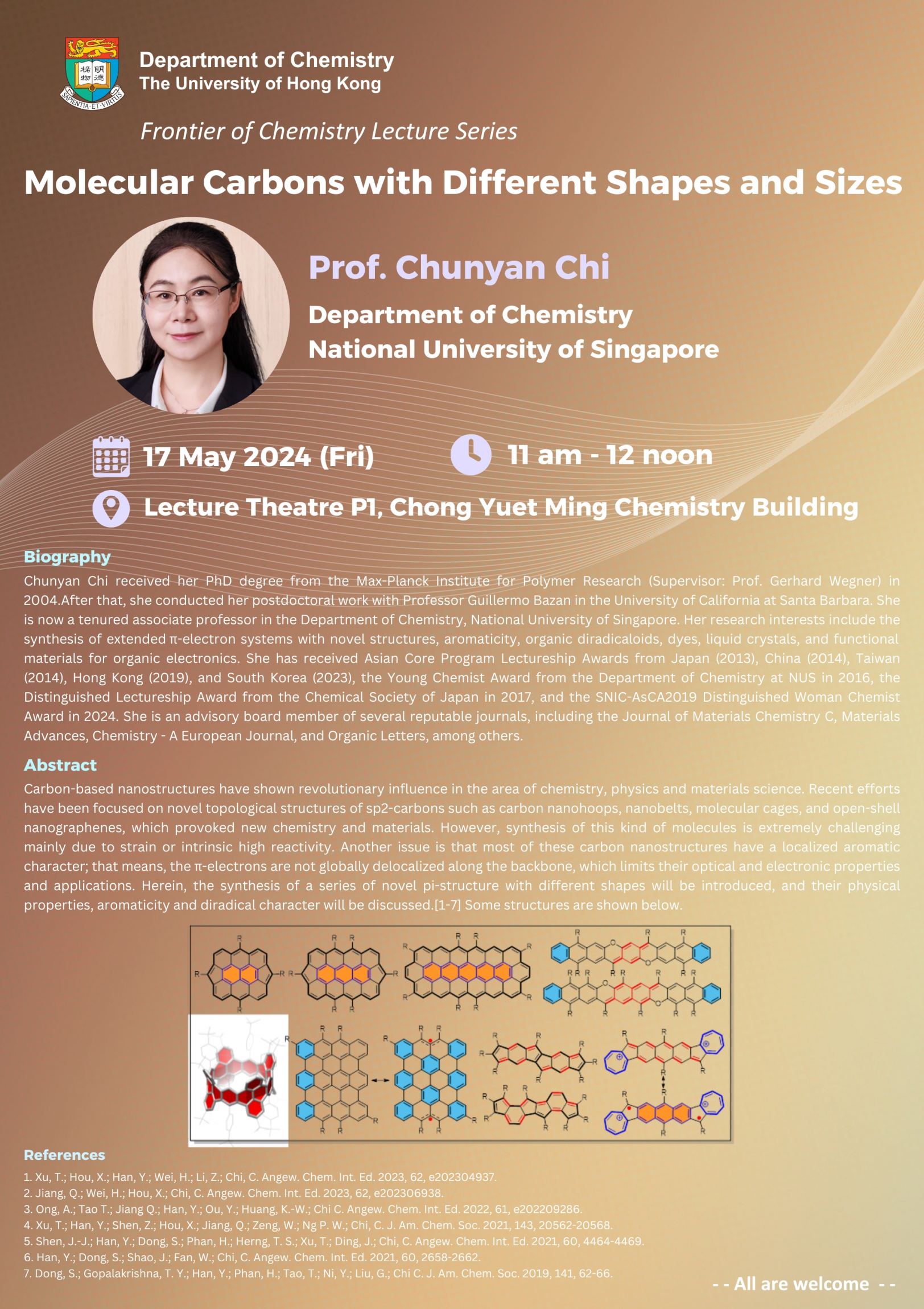| Date | 17 May 2024 |
| Time | 11:00 am - 12:00 noon |
| Venue | Lecture Theatre P1, Chong Yuet Ming Chemistry Building |
| Speaker | Prof. Chunyan Chi |
| Institution | Department of Chemistry, National University of Singapore |

Title:
Molecular Carbons with Different Shapes and Sizes
Schedule:
Date: 17th May, 2024 (Friday)
Time: 11 am - 12 noon (HKT)
Venue: Lecture Theatre P1, Chong Yuet Ming Chemistry Building
Speaker:
Biography:
Chunyan Chi received her PhD degree from the Max-Planck Institute for Polymer Research (Supervisor: Prof. Gerhard Wegner) in 2004.After that, she conducted her postdoctoral work with Professor Guillermo Bazan in the University of California at Santa Barbara. She is now a tenured associate professor in the Department of Chemistry, National University of Singapore. Her research interests include the synthesis of extended π-electron systems with novel structures, aromaticity, organic diradicaloids, dyes, liquid crystals, and functional materials for organic electronics. She has received Asian Core Program Lectureship Awards from Japan (2013), China (2014), Taiwan (2014), Hong Kong (2019), and South Korea (2023), the Young Chemist Award from the Department of Chemistry at NUS in 2016, the Distinguished Lectureship Award from the Chemical Society of Japan in 2017, and the SNIC-AsCA2019 Distinguished Woman Chemist Award in 2024. She is an advisory board member of several reputable journals, including the Journal of Materials Chemistry C, Materials Advances, Chemistry - A European Journal, and Organic Letters, among others.
Abstract:
Carbon-based nanostructures have shown revolutionary influence in the area of chemistry, physics and materials science. Recent efforts have been focused on novel topological structures of sp2-carbons such as carbon nanohoops, nanobelts, molecular cages, and open-shell nanographenes, which provoked new chemistry and materials. However, synthesis of this kind of molecules is extremely challenging mainly due to strain or intrinsic high reactivity. Another issue is that most of these carbon nanostructures have a localized aromatic character; that means, the π-electrons are not globally delocalized along the backbone, which limits their optical and electronic properties and applications. Herein, the synthesis of a series of novel pi-structure with different shapes will be introduced, and their physical properties, aromaticity and diradical character will be discussed.[1-7] Some structures are shown below.
References:
1. Xu, T.; Hou, X.; Han, Y.; Wei, H.; Li, Z.; Chi, C. Angew. Chem. Int. Ed. 2023, 62, e202304937.
2. Jiang, Q.; Wei, H.; Hou, X.; Chi, C. Angew. Chem. Int. Ed. 2023, 62, e202306938.
3. Ong, A.; Tao T.; Jiang Q.; Han, Y.; Ou, Y.; Huang, K.-W.; Chi C. Angew. Chem. Int. Ed. 2022, 61, e202209286.
4. Xu, T.; Han, Y.; Shen, Z.; Hou, X.; Jiang, Q.; Zeng, W.; Ng P. W.; Chi, C. J. Am. Chem. Soc. 2021, 143, 20562-20568.
5. Shen, J.-J.; Han, Y.; Dong, S.; Phan, H.; Herng, T. S.; Xu, T.; Ding, J.; Chi, C. Angew. Chem. Int. Ed. 2021, 60, 4464-4469.
6. Han, Y.; Dong, S.; Shao, J.; Fan, W.; Chi, C. Angew. Chem. Int. Ed. 2021, 60, 2658-2662.
7. Dong, S.; Gopalakrishna, T. Y.; Han, Y.; Phan, H.; Tao, T.; Ni, Y.; Liu, G.; Chi C. J. Am. Chem. Soc. 2019, 141, 62-66.
- ALL ARE WELCOME -
